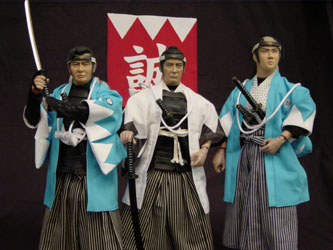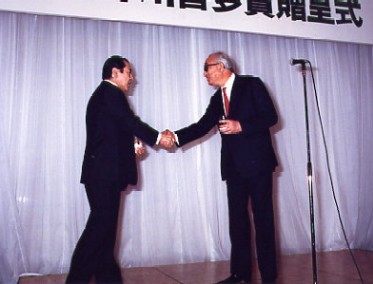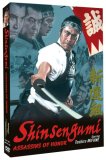| Reviews & Columns |
|
Reviews DVD TV on DVD Blu-ray 4K UHD International DVDs In Theaters Reviews by Studio Video Games Features Collector Series DVDs Easter Egg Database Interviews DVD Talk Radio Feature Articles Columns Anime Talk DVD Savant Horror DVDs The M.O.D. Squad Art House HD Talk Silent DVD
|
DVD Talk Forum |
|
|
| Resources |
|
DVD Price Search Customer Service #'s RCE Info Links |
|
Columns
|
|
|
Shinsengumi: Assassins of Honor (aka Band of Assassins)
Unlike the inherently compelling Chushingura, of which even pedestrian adaptations tend to be adequately entertaining, most versions of Shinsengumi, including this one, work as history lessons but much less so as drama. Partly this is because of the complex politicking that accompanied the upheaval of Japan during the Meiji Restoration of the 1860s, and also because the Shinsengumi largely consisted of traditionalist thugs who abused their authority and fame. (One might liken their actions to those of Iraq's hard-line insurgents.) AnimEigo / Samurai Cinema's DVD of the film doesn't help; though 16:9 enhanced, the transfer is quite poor.
Literally "Newly Selected Corps," the Shinsengumi was a controversial police-type force recruited to protect the Tokugawa Shogunate and to protect Kyoto from imperialists who would see it burned to the ground. Toshiro Mifune stars as one of its founders, Isami Kondo, a former farmer-turned-dojo master. He allies his band with several other factions, the most infamous being that led by Kamo Serizawa (Rentaro Mikuni), a mean drunk who severely damages the Shinsengumi's reputation through open acts of senseless murder and debauchery. Indeed, Serizawa becomes such an embarrassment that Kondo has him assassinated barely 40 minutes into the film.
Kondo assumes control of the Shinsengumi, whose other leaders include Toshijo Hijikata (Keiju Kobayashi) and Soji Okita (Kinya Kitaoji). In attempting to restore honor to the group, itself constantly on the verge of collapse through in-fighting, Kondo and Hijikata rigidly enforce a code of conduct, and some men are forced to commit seppuku lest they besmirch the Shinsengumi's name.
The film, while acknowledging the Shinsengumi's corruption, nonetheless glorifies its most loyal members and their adherence to the code of bushido. Not surprisingly, this is especially true of Mifune's idealist samurai, an El Cid-like tragic figure loyal to masters ready to brand him and his men as traitors when the need arises. Unfortunately, as was often the case for the actor at this point in his career, little is asked of him as an actor; the film demands nothing of him beyond his physical presence.
This is underscored by the supporting cast, nearly all veterans of other, far superior Mifune films. Yoko Tsukasa, who here plays his wife, had co-starred with Mifune in Masaki Kobayashi's thematically similar but far better Samurai Rebellion (1967); and Rentaro Mikuni had played a similar if much lowlier character opposite Mifune in Samurai I - Musashi Miyamoto (1954).
The result is that the film mechanically acts out various historical incidents, which are adequately though not engrossingly dramatized with the usual swordplay action against various Kyoto landmarks.** In short it's dull, populated with unlikable characters save for Mifune's Kondo. In this sense the film is almost like visiting an American Civil War battle site, with local actors meticulously recreating events for tourists. Japanese audiences were generally already familiar with the historical characters and events, but westerns audiences will likely find much of it confusing in the same way Japanese audiences might perceive a film about the Gunfight at the O.K. Corral.
The film was not a success, and marked the beginning of the end of Mifune's career as a leading man. His long association with director Akira Kurosawa ended with 1965's Red Beard, and though the two talked of working together on several projects during the 1970s, none were made and their relationship became increasingly strained. Two short years after Shinsengumi's release, Mifune retreated to television, in a weekly series that traded-in on his Yojimbo/warrior rogue image.
Video & Audio
Shinsengumi is presented in a 16:9 enhanced transfer that retains the film's original CinemaScope theatrical aspect ratio, but that's where the good news ends. Though "digitally remastered," according to the DVD box text, something like severe combing is evident throughout: in medium and long shots, especially when four-five or more actors are huddled within a frame (which is most of the time), the picture takes on a hazy blur, at its worst resulting in actors appearing to have four eyes and two mouths. This is less apparent in close-ups, but a good chunk of the film is downright headache-inducing.
The English subtitles that accompany the original mono mix are multi-colored, allowing viewers to keep track of who's saying what. As with other AnimEigo releases, a second subtitle option offers English that's limited to signs, banners, and the like, while various historical terms are annotated with even more text. As usual for AnimEigo, all the credits are subtitled.
Extra Features
Supplements are limited to a few production notes, an okay image gallery and a trailer.
Parting Thoughts
Undemanding samurai action fans and those with an interest in Japanese history might enjoy Shinsengumi, but the film is decidedly minor if epic in scope, and the disappointing transfer makes it even less attractive.
* Though most sources give the film's release date as 1970, the picture opened in Japan on a road show basis on December 5, 1969.
** It's interesting to consider that, for example, the intersection where the severed heads of anti-Shogunate ronin once were publicly displayed on sticks is now occupied by a Starbucks coffee shop.
Film historian Stuart Galbraith IV's most recent essays appear in Criterion's new three-disc Seven Samurai DVD and BCI Eclipse's The Quiet Duel. His audio commentary for Invasion of Astro Monster is due out in June.
|
| Popular Reviews |
| Sponsored Links |
|
|
| Sponsored Links |
|
|
| Release List | Reviews | Shop | Newsletter | Forum | DVD Giveaways | Blu-Ray | Advertise |
|
Copyright 2024 DVDTalk.com All Rights Reserved. Legal Info, Privacy Policy, Terms of Use,
Manage Preferences,
Your Privacy Choices | |||||||















